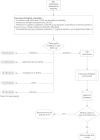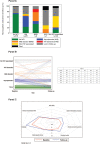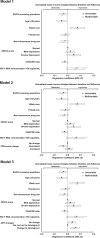Neurocognitive course at 2-year follow-up in a Swiss cohort of people with well-treated HIV
- PMID: 34411034
- PMCID: PMC8631148
- DOI: 10.1097/QAD.0000000000003057
Neurocognitive course at 2-year follow-up in a Swiss cohort of people with well-treated HIV
Abstract
Objective: The aim of this study was to examine neurocognitive course over time among people with well treated HIV.
Design: The Neurocognitive Assessment in the Metabolic and Aging Cohort (NAMACO) study is an ongoing, prospective, longitudinal, multicenter and multilingual study within the Swiss HIV Cohort Study (SHCS). Participants undergo neuropsychological assessment at baseline and two-yearly follow-up.
Setting: Seven SHCS centres.
Participants: Patients aged at least 45 years enrolled in the SHCS with fluency in the local language (French, German or Italian) and agreeing to participate in the NAMACO study: 981 participants at baseline, 720 at 2-year follow-up of whom 644 had complete data sets.
Intervention: Standardized neuropsychological assessment at baseline and 2-year follow-up.
Main outcome measure: Neurocognitive performance using Frascati criteria and mean z-scores.
Results: Four participants (of 644, 0.6%) had plasma HIV-1 RNA more than 50 copies/ml; median CD4+ cell count was 660 cells/μl. According to Frascati criteria, 204 participants (31.7%) had neurocognitive impairment (NCI) at baseline. NCI severity in these participants changed little over 2 years and comprehensive models based on Frascati criteria were not feasible. Examining mean z-scores, however, we observed neurocognitive stability or improvement over two years in five of seven neurocognitive domains assessed. Age at least 65 years (P = 0.02) and cognitive complaints (P = 0.004) were associated with neurocognitive decline, while black race (P = 0.01) and dolutegravir treatment (P = 0.002) were associated with improvement.
Conclusion: Frascati criteria were less sensitive in measuring NCI change and therefore unsuitable for following neurocognitive course in our cohort of people with well treated HIV. Examining neurocognitive course by mean z-score change, we observed stability or improvement.
Copyright © 2021 The Author(s). Published by Wolters Kluwer Health, Inc.
Conflict of interest statement
There are no conflicts of interest.
Figures



References
-
- Simioni S, Cavassini M, Annoni JM, Rimbault Abraham A, Bourquin I, Schiffer V, et al. . Cognitive dysfunction in HIV patients despite long-standing suppression of viremia. AIDS 2010; 24:1243–1250. - PubMed
-
- Underwood J, De Francesco D, Leech R, Sabin CA, Winston A, Pharmacokinetic and Clinical Observations in PeoPle Over FiftY (POPPY) Study. Medicalising normality? Using a simulated dataset to assess the performance of different diagnostic criteria of HIV-associated cognitive impairment. PLoS One 2018; 13:e0194760. - PMC - PubMed
Publication types
MeSH terms
LinkOut - more resources
Full Text Sources
Medical
Research Materials

